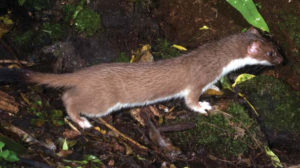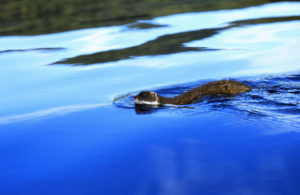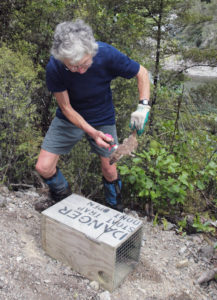Stoats are a cunning opponent and serious villain in New Zealand’s battle to save our native species. They’re efficient predators, can travel long distance and are good swimmers. They’re also notoriously bait-shy. So what can recent NZ research tell us about the best ways to tackle stoats?
First, an overview of public perceptions and what ordinary New Zealanders feel are acceptable ways to deal with stoats. In 2005, as part of the Department of Conservation’s stoat research programme, Gerard Fitzgerald, Nicholas Fitzgerald and Roger Wilkinson published the results of a telephone survey looking at attitudes to conservation, stoats, current stoat control methods and the possible use of various biological control methods.
A random sample of 1002 members of the public were surveyed and showed a clear preference for the use of fatal traps in stoat control.The use of poison to kill stoats was less publically acceptable and there was clear opposition to some potential methods of biological control, such as introducing a virulent strain of the distemper virus. The use of diseases that could affect other animals was not supported and biological control designed to reduce the stoat’s fertility was only marginally acceptable to the New Zealand public.
The researchers concluded that the acceptability of existing and new forms of stoat control to the general public would depend on the specificity of the control, its effectiveness and the humaneness of the control method and that cost was likely to be a relatively minor consideration. Based on their survey, it was the view of the researchers that a focus on developing better stoat trapping methods and mechanisms was the most socially acceptable option for researchers and decision-makers to follow. Social acceptability of stoats and stoat control methods – a survey of the New Zealand public (2005)
It’s known that stoats are good swimmers – but just how good are they? A study by Carolyn King, Andrew Veale, Bruce Patty and Lisa Hayward, published in Biological Invasions in May 2014, looks at the swimming capabilities of nine stoats (each tested once). The stoats were observed swimming against an endless current in a flume at the Aquatic Research Centre, University of Waikato, with their paddling action, speed and endurance recorded.
Stoats are reputed to be able to swim 1-1.5km and islands further from the New Zealand mainland have been assumed to be safe from stoat invasion. Regular monitoring for stoats on such islands has not been considered necessary. The authors, however, questioned this assumption after a stoat was found on Rangitoto Island (3 km offshore) in 2010, and another which was deduced to have reached Kapiti (5 km offshore) in 2009.
Four of the nine stoats in the study swam strongly for more than an hour, including one female who covered 1.8 km in nearly two hours non-stop. While the conditions in the study were artificial, the results do support the possibility that stoats can swim further than 1.5km. The authors conclude that “the ‘risk zone’ for stoat reinvasions of inshore islands has been seriously under-estimated”. Swimming capabilities of stoats and the threat to inshore sanctuaries (2014)
A 2015 study by Des Smith of Wildland Consultants, Christchurch and Richard Clayton, Dean Anderson and Bruce Warburton of Landcare Research, Lincoln looked at the problem of determining optimal control intensity for cost-effective predator management.
Smith, Clayton, Anderson and Warburton used stoat home-range data in a modelling approach to determine the most cost-effective spacing of control-device lines. They used three different methods to calculate home-range widths of female stoats and then calculated the probability of stoats encountering a control device line, with varying distances between the control lines. The researchers determined the optimal distance between control lines needed to ensure that they would intercept with 100% of female stoat home ranges.
The optimal distance between control lines differed, depending on what method had been used to calculate home-range width. Where good home-range data was available, better predictions – and therefore more cost-effective control – could be made using the kernels method to simulate home-range. Where insufficient data was available, simulating home-range width across point data gave a more conservative (but less cost-effective) option.
The researchers recommended that where there was uncertainty about the intensity of control to apply, managers should give priority to collecting home-range data. This would mean that simulation on kernels could be used to determine control-line spacing – with the more accurate prediction of this method giving greater cost-efficiency. Using home-range data to optimise the control of invasive animals (2015)




